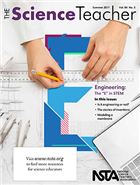Science 2.0: Align Your Curriculum With the ISTE Standards
By sstuckey
Posted on 2017-07-13
Our previous seven columns have been devoted to integrating the International Society for Technology in Education’s (ISTE) standards into the science classroom. Yet, knowing which activities align with the standards and determining where they fit within the curriculum can be challenging. This month, we provide some scaffolding to help teachers align the ISTE standards to the example activities in our previous columns.
There’s a common misconception that curriculum documents explain when material connected to a content standard would most benefit from using technology-based tools. A simple exercise shows this is untrue. Searching the word technology in a PDF version of the Next Generation Science Standards yields dozens of occurrences. In most of those cases, however, technology is connected solely to the crosscutting concept of “Connections to Engineering, Technology, and Applications of Science,” so the search isn’t very helpful.
Even where the term technology appears within a standard, the focus remains more on tool use instead of how students can choose tools that will best help them demonstrate understanding of content. An example of this in the NGSS is actually a connection to the Common Core State Standards and relates to a student’s ability to graph. Even here, the use of technology serves only to carry out a specific function and is not used in a higher-order way.
Search for key action verbs instead
What, then, would be a better way to mine the NGSS for the use of technology in classroom activities? Instead of searching for the word technology, let’s search for key action verbs (e.g., collaborate, communicate, organize) that support the seven ISTE standards. Searching for collaborate, for example, yields nearly 20 pages of results, many of which are directly cited within the science and engineering practices (SEP) and describe the student actions that should be seen in the science classroom. Just one example indicates that students should be able to “Plan and conduct an investigation collaboratively to produce data to serve as the basis for evidence to answer a question.” Now, we can call upon the resources provided in our column about global collaborators (Smith and Mader 2017), in which students use digital tools to collaborate with their peers.
To most effectively make use of this strategy, begin with the four indicators that accompany each ISTE standard and search for the action verbs that will evidence student learning. The search leads us to words such as communicate, which can be found in another SEP that encourages students to “communicate solutions with others in oral and/or written forms using models and/or drawings that provide detail about scientific ideas.” Now, you can draw upon some of the tools that we connected to the Creative Communicator standard (Smith and Mader 2017) to strengthen students’ skills in this SEP.
Conclusion
Once we understand that content, the NGSS, and ISTE standards are complementary, we will begin to see how technology can most appropriately support and transform student learning activities.
Ben Smith (ben@edtechinnovators.com) is an educational technology program specialist, and Jared Mader (jared@edtechinnovators.com) is the director of educational technology, for the Lincoln Intermediate Unit in New Oxford, Pennsylvania. They conduct teacher workshops on technology in the classroom nationwide.
References
International Society for Technology in Education (ISTE). 2016. The 2016 ISTE standards for students. Arlington, VA: ISTE. http://bit.ly/ISTE-standards
Smith, B., and J. Mader. 2017. Communicating science creatively. The Science Teacher 84 (4): 10. http://bit.ly/TST-communicate
Smith, B., and J. Mader. 2017. Help students become global collaborators. The Science Teacher 84 (3): 9. http://bit.ly/TST-collaborate
Editor’s Note
This article was originally published in the Summer 2017 issue of The
Science Teacher journal from the National Science Teachers Association (NSTA).
Get Involved With NSTA!
 Join NSTA today and receive The Science Teacher, the peer-reviewed journal just for high school teachers; to write for the journal, see our Author Guidelines, Call for Papers, and annotated sample manuscript; connect on the high school level science teaching list (members can sign up on the list server); or consider joining your peers at future NSTA conferences.
Join NSTA today and receive The Science Teacher, the peer-reviewed journal just for high school teachers; to write for the journal, see our Author Guidelines, Call for Papers, and annotated sample manuscript; connect on the high school level science teaching list (members can sign up on the list server); or consider joining your peers at future NSTA conferences.
Disclaimer: The views expressed in this blog post are those of the author(s) and do not necessarily reflect the official position of the National Science Teaching Association (NSTA).


